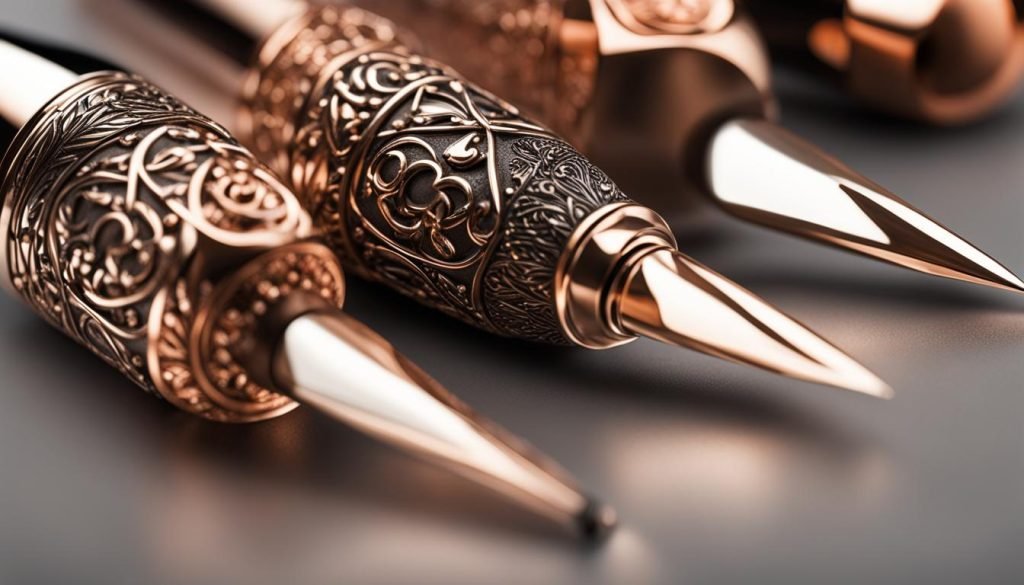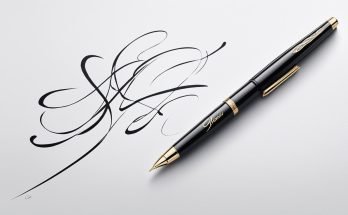Copperplate Calligraphy Secrets Unveiled: Master Elegance in Every Stroke!
Copperplate calligraphy, also known as copperplate script, is a timeless art form that combines precision and grace to create stunning handwritten compositions. With its smooth curves and fine details, it exudes elegance in every stroke. Whether you’re a seasoned calligrapher or just starting out, mastering copperplate calligraphy can elevate your writing to new levels of sophistication.
Key Takeaways:
- Copperplate calligraphy is a beautiful and elegant form of handwriting.
- It requires practice and patience to master the basic strokes and letter forms.
- Essential tools and materials for copperplate calligraphy include pointed pen nibs, oblique pen holders, calligraphy ink, calligraphy paper, and guidelines.
- Consistency in letter size, shape, slant, and spacing is crucial for achieving a polished look.
- Adding flourishes and advanced techniques can enhance the artistic touch and individual style of your copperplate calligraphy.
Essential Tools and Materials for Copperplate Calligraphy

When it comes to practicing copperplate calligraphy, having the right tools and materials is essential. Here are some key items that every calligrapher should have:
- Pointed Pen Nibs: Pointed pen nibs are specifically designed for creating the thick and thin strokes that are characteristic of copperplate calligraphy. Popular options include the Zebra G and Leonardt Principal EF nibs, which offer excellent control and versatility.
- Oblique Pen Holders: An oblique pen holder is recommended for copperplate calligraphy as it allows for the proper slant in your writing. This angled pen holder helps achieve the graceful curves that define copperplate calligraphy.
- Calligraphy Ink: Quality calligraphy ink is crucial for smooth and consistent writing. Some popular choices include Higgins Eternal and Sumi ink, which offer excellent flow and rich color.
- Calligraphy Paper: Choosing the right paper is important to prevent ink feathering and ensure optimal writing results. Look for calligraphy paper with a slight tooth, such as Rhodia or Strathmore, to provide the right balance of smoothness and grip.
- Guidelines: Guidelines are a useful tool for maintaining consistent letter size, slant, and spacing. They act as a reference point to help you create uniform and visually appealing calligraphy.
Having these essential tools and materials will set you on the path to mastering copperplate calligraphy. Experiment with different nibs, holders, inks, and papers to find the combination that works best for your style and preferences. Remember, practice is key, so keep honing your skills and exploring new techniques to create stunning copperplate calligraphy compositions.
| Tool/Material | Description |
|---|---|
| Pointed Pen Nibs | Specialized nibs for creating the thick and thin strokes of copperplate calligraphy. Examples include Zebra G and Leonardt Principal EF. |
| Oblique Pen Holders | Pen holders with an angled design that helps achieve the proper slant in copperplate calligraphy writing. |
| Calligraphy Ink | Inks specifically formulated for smooth and consistent flow in calligraphy writing. Popular options include Higgins Eternal and Sumi ink. |
| Calligraphy Paper | Paper with a slight tooth that provides the right grip and prevents ink feathering. Rhodia and Strathmore are popular choices. |
| Guidelines | Reference lines or grids that assist in maintaining uniform letter size, slant, and spacing in copperplate calligraphy. |
By investing in these tools and materials, you’ll be well-equipped to create beautiful copperplate calligraphy and unlock your creativity in every stroke.
Expert Tip: Experiment and Explore
Don’t be afraid to experiment with different tools and materials. Each calligrapher has their own unique preferences, and what works for one person may not work for another. Explore various nibs, holders, inks, and papers to find your ideal combination and unleash your artistic potential.
Mastering the Basic Strokes of Copperplate Calligraphy

Before diving into letter forms, it’s important to practice and master the basic strokes of copperplate calligraphy. These strokes serve as the building blocks for creating the elegant and flowing letters that define this art form. By honing your skills in these fundamental strokes, you’ll gain the foundation needed to create beautiful copperplate calligraphy compositions.
The first stroke to master is the entrance stroke, a thin, upward curve often used to begin lowercase letters. This stroke sets the stage for the elegant and graceful look of copperplate calligraphy. Next, focus on the underturn and overturn strokes, which are essential in creating the unique U-shaped forms seen in many copperplate letters. These strokes give the letters their distinctive and flowing appearance.
The oval stroke is another key element of copperplate calligraphy. It is used to create rounded shapes like “o” and “a.” With practice, you’ll be able to achieve smooth and consistent oval strokes that add elegance to your writing. Lastly, the compound curve stroke combines convex and concave curves and is used in letters like “h” and “m.” By mastering this stroke, you’ll be able to create letters with a sense of balance and harmony.
Table: Overview of Basic Strokes in Copperplate Calligraphy
| Stroke | Description |
|---|---|
| Entrance Stroke | A thin, upward curve used to begin lowercase letters |
| Underturn | A stroke that creates a U-shaped form, moving from left to right |
| Overturn | A stroke that creates a U-shaped form, moving from right to left |
| Oval | A rounded stroke used to create shapes like “o” and “a” |
| Compound Curve | A stroke that combines convex and concave curves, used in letters like “h” and “m” |
By focusing on these basic strokes, you’ll develop the necessary skills to create the elegant and graceful letters that define copperplate calligraphy. Practice each stroke individually, paying attention to your hand position, pressure, and movement. With dedication and persistence, you’ll be able to master these fundamental strokes and take your copperplate calligraphy to new heights.
Exploring Copperplate Letter Forms and Spacing

Copperplate calligraphy is a form of handwriting that emphasizes the beauty of letter forms and the consistency of spacing. Whether you’re a beginner or an experienced calligrapher, mastering the letter forms and understanding how to create an elegant slant can greatly enhance your copperplate calligraphy skills.
The letter forms in copperplate calligraphy are characterized by the contrast between thick and thin strokes, which add depth and visual appeal to the writing. This contrast is achieved through the use of pointed pen nibs and proper techniques. The thick strokes are created by applying more pressure on the nib, while the thin strokes are achieved by releasing pressure. By mastering these techniques, you can achieve the desired thickness and thinness in your strokes, giving your copperplate calligraphy a professional and sophisticated look.
Consistency in letter size, shape, and slant is also crucial in copperplate calligraphy. This consistency ensures that your writing appears uniform and visually pleasing. It’s important to practice maintaining a consistent slant, as well as paying attention to the overall spacing between letters and words. Proper letter spacing contributes to the readability of your writing and creates a harmonious flow.
Table: Common Copperplate Letter Forms and Spacing
| Letter | Form | Slant | Thick and Thin Strokes | Letter Spacing |
|---|---|---|---|---|
| A | Oval with a descending stem | Right-slanting | Contrasting thick and thin strokes | Optimal spacing between other letters |
| B | Compound curve followed by a vertical line | Right-slanting | Contrasting thick and thin strokes | Optimal spacing between other letters |
| C | Oval with a slight right-slanting curve | Right-slanting | Contrasting thick and thin strokes | Optimal spacing between other letters |
| D | Compound curve followed by a vertical line | Right-slanting | Contrasting thick and thin strokes | Optimal spacing between other letters |
By exploring the various letter forms and focusing on slant, thick and thin strokes, and letter spacing, you can elevate your copperplate calligraphy to a new level of elegance. With practice and attention to detail, you’ll be able to create beautiful compositions that showcase the timeless beauty of copperplate calligraphy.
Mastering Uppercase Letters in Copperplate Calligraphy

In copperplate calligraphy, mastering uppercase letters, also known as majuscules, is an important step towards achieving elegance and sophistication in your writing. Majuscules are often constructed around the use of ovals, which are created by combining thick and thin strokes. These strokes give the letters a distinctive shape and add depth to your calligraphy. To create contrast, the shade stroke is used to add depth and dimension to the letters, while the hairline stroke adds delicate refinement.
The compound curve stroke is particularly prominent in uppercase letters like “B” and “R” and involves combining convex and concave curves to create a flowing and harmonious shape. By focusing on these majuscule strokes and practicing proper construction, you’ll be able to create uppercase letters that exude sophistication and style.
Creating uppercase letters requires precision and attention to detail. Each stroke must be carefully executed to maintain uniformity and balance within the composition. By practicing consistently and paying attention to the intricacies of each stroke, you’ll be able to develop your own unique style and add a touch of elegance to your calligraphy.
Majuscule Stroke Examples:
| Letter | Construction | Example |
|---|---|---|
| A | Oval with shade and hairline stroke | |
| B | Compound curve with shade and hairline stroke | https://www.youtube.com/watch?v=2rHpzVpX7UU |
| C | Oval with shade and hairline stroke | |
| D | Compound curve with shade and hairline stroke |
By mastering uppercase letters in copperplate calligraphy, you’ll be able to elevate your compositions to a new level of elegance. The combination of precise strokes, attention to detail, and individual style will allow you to create visually stunning and sophisticated calligraphy.
Mastering Lowercase Letters in Copperplate Calligraphy
Now that you’ve become comfortable with uppercase letters in copperplate calligraphy, it’s time to move on to lowercase letters, also known as minuscules. These smaller letters require a different set of strokes to create their unique shapes and forms. By mastering the underturn, overturn, loop, connector, and other minuscule strokes, you’ll be able to add depth and harmony to your copperplate calligraphy compositions.
The underturn stroke is essential in creating the U-shaped forms seen in many lowercase letters. It involves starting with a thin upward stroke, then transitioning into a thick downward curve. The overturn stroke, on the other hand, begins with a thick downward stroke, then transitions into a thin upward curve. Both of these strokes are fundamental in creating the elegant and flowing look of copperplate calligraphy.
In addition to the underturn and overturn strokes, the loop and connector strokes are important in adding flourish and cohesion to your copperplate calligraphy. The loop stroke is used in letters like “g” and “j,” creating a graceful loop at the bottom of the letter. The connector stroke, as the name suggests, helps to link letters together within a word, creating a seamless and visually appealing flow.
As with any new technique, practice is key in mastering lowercase letters in copperplate calligraphy. By focusing on the proper construction of each stroke and paying attention to the overall harmony and balance of your composition, you’ll be able to create lowercase letters that perfectly complement your uppercase letters and showcase your skill and creativity.
Table: Minuscule Strokes in Copperplate Calligraphy
| Stroke | Description |
|---|---|
| Underturn | A thin upward stroke transitioning into a thick downward curve. |
| Overturn | A thick downward stroke transitioning into a thin upward curve. |
| Loop | A graceful loop stroke at the bottom of letters like “g” and “j”. |
| Connector | A stroke that links letters together within a word. |
Writing Numbers and Punctuation in Copperplate Calligraphy
In the art of calligraphy copperplate writing, numbers and punctuation marks serve as essential elements that contribute to the overall structure and clarity of your compositions. By paying attention to these details, you can ensure that your message is easily understood and visually appealing.
When writing numbers in copperplate calligraphy, it is important to maintain consistency in style and size. Whether you are writing single digits or larger numbers, ensure that each numeral is proportionate and follows the same design principles as the rest of your calligraphy. Attention to detail in forming each digit will enhance the overall cohesiveness of your composition. Remember to leave adequate space between numbers to maintain clarity and readability.
Punctuation marks are equally important in copperplate calligraphy. They provide structure to your writing and help guide the reader through your composition. Each punctuation mark should be crafted with care and positioned appropriately in relation to the surrounding text. Take the time to give these marks the attention they deserve, as they can greatly impact the overall aesthetic and flow of your calligraphy piece.
| Punctuation Mark | Description |
|---|---|
| . | Period |
| , | Comma |
| ; | Semicolon |
| : | Colon |
| ! | Exclamation Mark |
| ? | Question Mark |
By mastering the art of writing numbers and punctuation in copperplate calligraphy, you can elevate the structure, clarity, and overall impact of your compositions. Incorporate these elements thoughtfully and consistently to create visually stunning and expressive pieces of calligraphy art.
Adding Flourishes and Advanced Techniques to Copperplate Calligraphy
Now that you have mastered the basics of copperplate calligraphy, it’s time to take your skills to the next level by adding flourishes and exploring advanced techniques. Flourishes are decorative elements that add an artistic touch to your calligraphy, making it uniquely yours. They can range from simple, elegant swirls to intricate, elaborate designs.
When incorporating flourishes, remember to maintain consistency with the overall style of your composition. Consider the placement and size of your flourishes to ensure they enhance rather than overpower the main text. Experiment with different types of flourishes and find the ones that resonate with your individual style and creative vision.
As you delve into advanced techniques, you can further refine and expand your repertoire of copperplate calligraphy. Try experimenting with alternative letterforms, such as variations on the basic strokes and alternate letter shapes. Explore different shading techniques to add depth and dimension to your writing. Push the boundaries of traditional copperplate calligraphy while still maintaining its elegance and grace.
Quotes from Calligraphy Experts
“Flourishes are like the signature of a calligrapher – they add a personal touch and convey the artist’s unique style.” – Emily Roberts, Calligraphy Enthusiast
“Advanced techniques in copperplate calligraphy allow you to explore new possibilities and develop your own artistic voice.” – Daniel Thompson, Professional Calligrapher
Remember, practice is crucial when it comes to mastering these advanced techniques. Set aside dedicated time to experiment, refine, and perfect your skills. As you continue to grow as a calligrapher, your individual style will evolve, resulting in truly remarkable pieces of art. Embrace the beauty and creativity of copperplate calligraphy and let your imagination soar.
Conclusion
In conclusion, Copperplate Calligraphy is a timeless art form that allows you to express your creativity and add a touch of elegance to any piece of writing. By learning the foundational skills, practicing the basic strokes, and mastering letter forms and spacing, you can create beautiful compositions that showcase your attention to detail.
Throughout this article, we have explored the essential tools and materials needed for Copperplate Calligraphy, as well as the importance of mastering the basic strokes and understanding letter forms and spacing. We have also discussed how to create stunning uppercase and lowercase letters, as well as the role of numbers and punctuation marks in your compositions.
Finally, we encourage you to experiment with flourishes and advanced techniques to develop your own unique style and make your Copperplate Calligraphy truly stand out. With dedication and practice, you can master this art form and bring elegance and sophistication to your handwritten pieces. So, grab your pen and let your creativity flow through every stroke!
FAQ
What is copperplate calligraphy?
Copperplate calligraphy is a beautiful and elegant form of handwriting that uses graceful curves and distinctive letter forms to create a unique and sophisticated style of writing.
What tools and materials do I need for copperplate calligraphy?
Essential tools and materials for copperplate calligraphy include pointed pen nibs, an oblique pen holder, quality calligraphy ink, suitable calligraphy paper, and guidelines for maintaining consistent letter size and spacing.
How can I master the basic strokes of copperplate calligraphy?
By practicing and mastering the entrance stroke, underturn, overturn, oval, and compound curve strokes, you can develop the foundational skills needed for creating beautiful copperplate calligraphy.
What should I focus on to achieve proper letter forms and spacing in copperplate calligraphy?
It is important to focus on achieving consistent slant, contrast between thick and thin strokes, and proper letter spacing to create a polished and elegant look in copperplate calligraphy.
How can I master uppercase letters in copperplate calligraphy?
By practicing the majuscule strokes, which are built around ovals and include shade, hairline, and compound curve strokes, you can create uppercase letters that exude sophistication and style.
What about lowercase letters in copperplate calligraphy?
Mastering the underturn, overturn, loop, and connector strokes is essential for creating the U-shaped forms and flourishes seen in many lowercase letters of copperplate calligraphy.
How can I incorporate numbers and punctuation marks into my copperplate calligraphy?
By giving attention to consistent styles, spacing, and alignment, you can effectively use numbers and punctuation marks to provide structure and clarity to your copperplate calligraphy compositions.
Can I add flourishes and advanced techniques to my copperplate calligraphy?
Yes, once you have a solid foundation, you can experiment with adding flourishes and advanced techniques to enhance the elegance and artistic touch of your copperplate calligraphy.
What is the essence of copperplate calligraphy?
Copperplate calligraphy is a timeless art form that brings elegance and sophistication to the written word, allowing you to express your creativity and attention to detail through every stroke.




